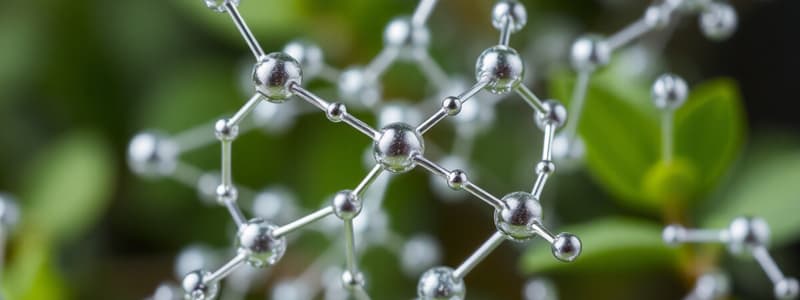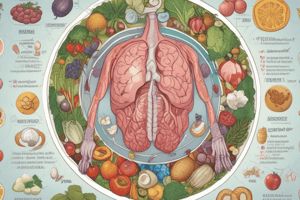Podcast
Questions and Answers
Which macronutrient should compose 45-65% of daily calories?
Which macronutrient should compose 45-65% of daily calories?
- Fats
- Proteins
- Vitamins
- Carbohydrates (correct)
What is the primary function of complex sugars like starch?
What is the primary function of complex sugars like starch?
- They produce energy in the form of ATP slowly. (correct)
- They only serve as dietary fiber.
- They provide energy immediately.
- They are not metabolized by the body.
Which type of fat is considered beneficial and usually liquid at room temperature?
Which type of fat is considered beneficial and usually liquid at room temperature?
- Saturated fats
- Trans fats
- Cholesterol
- Unsaturated fats (correct)
What percentage of total fats should saturated fats ideally make up?
What percentage of total fats should saturated fats ideally make up?
Which of these is classified as a potentially harmful type of fat?
Which of these is classified as a potentially harmful type of fat?
During digestion, nutrients are primarily distributed to cells via which process?
During digestion, nutrients are primarily distributed to cells via which process?
What kind of molecules are micronutrients and why are they important?
What kind of molecules are micronutrients and why are they important?
What is the function of cholesterol in the body?
What is the function of cholesterol in the body?
What role does saliva play in digestion?
What role does saliva play in digestion?
What is the primary function of the stomach in digestion?
What is the primary function of the stomach in digestion?
Which of the following describes the primary function of the small intestine?
Which of the following describes the primary function of the small intestine?
What causes the activation of the pepsin enzyme in the stomach?
What causes the activation of the pepsin enzyme in the stomach?
What is the role of the pancreas in digestion?
What is the role of the pancreas in digestion?
What happens if food waste moves too quickly through the large intestine?
What happens if food waste moves too quickly through the large intestine?
What is the main purpose of the large intestine during digestion?
What is the main purpose of the large intestine during digestion?
How long does the entire digestive process typically take after eating?
How long does the entire digestive process typically take after eating?
What is the primary role of proteins in the body?
What is the primary role of proteins in the body?
Which type of amino acids cannot be synthesized by the body?
Which type of amino acids cannot be synthesized by the body?
In which organelle does photosynthesis predominantly occur?
In which organelle does photosynthesis predominantly occur?
What process describes the breakdown of food into simpler molecules by the action of enzymes?
What process describes the breakdown of food into simpler molecules by the action of enzymes?
What type of organism are autotrophs?
What type of organism are autotrophs?
Which of the following processes involves the uptake of food into the digestive system?
Which of the following processes involves the uptake of food into the digestive system?
Which of the following best describes egestion?
Which of the following best describes egestion?
What is the function of HDL cholesterol in the body?
What is the function of HDL cholesterol in the body?
Flashcards are hidden until you start studying
Study Notes
How Different Chemical Environments Support Life
- Healthy lives depend on the balance of chemical systems within the body and the environment.
- Understanding nutrient breakdown and absorption is essential for maintaining this balance.
Nutritional Components
- Nutrients are substances that cells use for various functions during metabolism.
- Nutrients are categorized into micronutrients (e.g., iron, iodine, vitamin A) and macronutrients (e.g., proteins, carbohydrates, fats).
Carbohydrates
- Composed of carbon, hydrogen, and oxygen.
- Classified into:
- Simple sugars (e.g., glucose): quick energy through ATP production.
- Complex sugars (e.g., starch): slower energy release, providing steady ATP.
- Recommended intake: Carbohydrates should constitute 45-65% of daily caloric intake.
Fats (Lipids)
- Should account for 20-35% of daily calorie intake.
- Divided into:
- Unsaturated fats: Healthy, liquid at room temperature (e.g., olive oil, nuts).
- Saturated fats: Less healthy, solid at room temperature; limit to 10% of total fat intake (e.g., butter, fatty meats).
- Trans fats: Harmful, found in processed foods; linked to health risks.
Cholesterol Types
- LDL cholesterol: Low-density, necessary for cell membrane construction but can cause artery blockages.
- HDL cholesterol: High-density, helps remove LDL cholesterol from blood vessels, promoting healthy circulation.
Proteins
- Comprised of carbon, hydrogen, oxygen, and nitrogen; essential for body structure.
- Broken down into amino acids:
- Essential amino acids: Cannot be synthesized by the body.
- Nonessential amino acids: Can be produced by the body.
- Functions include muscle building and acting as enzymes to enhance metabolic reactions.
Nutrition in Living Organisms
- Autotrophs: Produce their own food using solar energy (e.g., green plants performing photosynthesis).
- Heterotrophs: Obtain food from external sources (e.g., mammals).
Digestive Process
- Digestion: Breakdown of food into simple nutrients.
- Ingestion: Taking in substances via mouth.
- Egestion: Expelling undigested waste from the digestive system.
- Absorption: Nutrient movement from intestines into the bloodstream.
- Assimilation: Use of absorbed nutrients in body cells.
Structure of the Digestive System
- Mouth: Mechanical digestion via teeth; saliva contains amylase to break down starch.
- Esophagus: Transports food (bolus) to the stomach via muscle contractions.
- Stomach: Muscular bag with acids and enzymes; secretes gastric juice containing pepsin and hydrochloric acid.
- Small Intestine: Long tube where food is mixed with digestive enzymes; absorbs nutrients into the bloodstream.
- Pancreas: Produces enzymes that aid digestion in the small intestine.
- Liver: Produces bile to emulsify fats and detoxify substances like alcohol.
- Gall Bladder: Stores bile produced by the liver.
- Large Intestine: Reabsorbs water from waste; helps manage waste elimination.
Timeframe of Digestion
- The entire digestive process generally takes 30 to 40 hours post-ingestion.
Studying That Suits You
Use AI to generate personalized quizzes and flashcards to suit your learning preferences.




